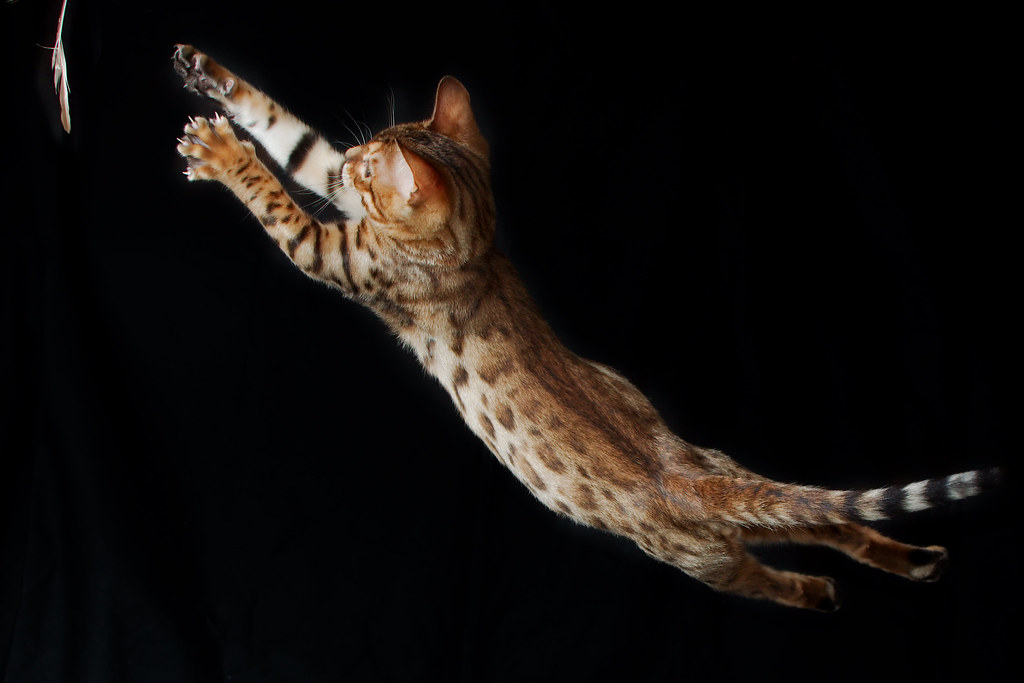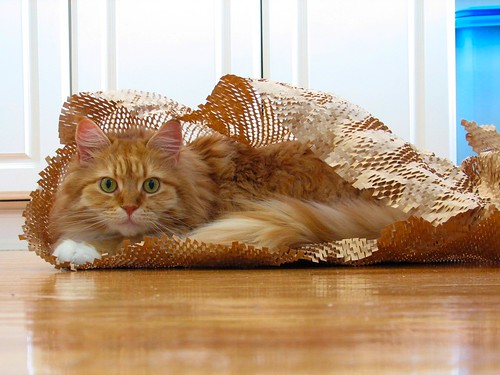As pet parents, we are tasked with the responsibility of keeping our cats happy and healthy. As a veterinarian, I have come to understand the importance of providing for their emotional as well as physical needs. This includes play! If you share your home with a feisty feline, you have likely experienced the joy of playing with or watching a cat play. Cats are very different from other domestic pets, such as dogs, and their play style is an example of this. While some cats are happy to fetch a ball, most are not. Feline playtime should stimulate and engage your cat’s natural instincts. Let’s explore what this means, the best types of cat toys, and tips for making the most of playtime with YOUR cat.
The Benefits of Playtime for Cats
Exercise
One of the clear benefits of playtime for your cat is exercise. This is especially important as 63% of pet cats are considered overweight or obese worldwide. Keeping your cat at an ideal body weight will help reduce their risk for certain diseases, such as diabetes and arthritis. Building muscle, stretching, and improving circulation are also benefits of playtime.
Mental Stimulation
Stalking, pouncing, chasing, and catching are part of your cat’s natural hunting instincts. While indoor cats may catch the occasional spider, one of the main ways for them to exercise these instincts is through play. Using these skills will help keep your cat sharp and focused, reduce boredom and problem behaviors, and be fun for the whole family.
In addition to hunting, your cat will also need outlets for their other natural instincts, including exploration, climbing, perching, and scratching.
Bonding
Playtime is a great way to strengthen the bond that you share with your cat. While some cats may love to get cozy on your lap, others are more aloof. Playtime is a great way for you to interact and bond with these furry family members.
Improve Problem Behaviors
Providing your cat with appropriate enrichment, including playtime, can help decrease stress, boredom, and associated problem behaviors such as urinating outside the litter box, unwanted scratching, and excessive vocalization at night. If you have any concerns about your cat’s behavior, it is best to see your vet to rule out any medical causes. They will then be able to help you come up with a plan or refer you to a veterinary behaviorist.
Types of Cat Toys
With multiple types of cat toys available, choosing a toy can be overwhelming for pet parents. The guide below can help you pick some options to engage your cat while allowing them to use their natural instincts.
Feeding Toys
Cats in the wild hunt for their food multiple times per day. While our feline friends have adapted to eating their meals from a bowl, they will love the chance to use their hunting skills. Some feeding toys, such as this one designed by a veterinarian, are meant to fully replace a food bowl. Others can be used in addition to meal feeding.
Interactive Toys
Feather wands and laser pointers are great interactive toys that you can use to play with your cat. They will love stalking, running, and jumping to catch these toys.
Toys Resembling Prey
Another way to stimulate your cat’s natural hunting instinct is to provide toys that resemble prey species, such as mice and birds. Furry toy mice and toys with feathers are often popular with cats for this reason. Many cats also enjoy toys that move on their own or make noises, to make the hunt more exciting.
Catnip Toys
Catnip can be a fun experience for many cats (50-70% of cats will respond to catnip). This herb acts as a stimulant when inhaled and a sedative when ingested. Feel free to experiment with the many forms of catnip available to see how your cat reacts. You may find it can be a fun addition to your playtime.
Climbing and Scratching Toys
https://www.rawpixel.com/search/cat%20condo?page=1&sort=curated&topic_group=_topics
Cats love to perch and observe their surroundings from high up (such as a tall scratching post or cat climber). Scratching is another normal feline behavior, which allows your cat to stretch their muscles and mark their territory. Consider trying scratching posts in various textures and shapes – when you find one that works best for your cat, it should help prevent any unwanted scratching on furniture or carpeting.
Homemade Toys
Cat toys don’t have to be expensive or complex. Many cats will be happy with objects that you have around the house, such as a cardboard box to explore and hide in, or a crinkled up piece of paper to bat around.
Toys to Avoid
There are certain toys that should be avoided. While a ball of yarn may be enticing, it is not a safe toy for your cat. Yarn, ribbons, and string can become lodged in the intestines causing an obstruction known as a linear foreign body. This is a medical emergency that requires immediate surgery and, in some cases, can be fatal. Toys that have been damaged or have loose parts that can be swallowed should also be tossed.
Choosing a Toy for YOUR Cat
Just like us, cats have different preferences and personalities. It will take some trial and error to find the best type of toy for your individual cat.
- Kittens and young cats with energy to burn may love chasing a laser pointer or feather toy.
- Food-motivated felines may respond especially well to feeding toys.
- Whether its mice, birds, or bugs, cat toys often imitate natural prey species. You can try this fun activity to help identify your cat’s prey preference. Your hunter will appreciate it!
Tips for Playing With Your Cat
- To get ready for playtime, gather some toys and your cat in a quiet area where they will be able to focus.
- Begin by wiggling or twitching a toy just out of their reach. Many cats will love to stalk, chase, and pounce on it. To keep your cat engaged, be sure that you sometimes let them catch the toy.
- Try to make playtime part of your daily routine. It is recommended to aim for 5-15 minute play sessions a few times per day, but some cats will want to play more or less. If you keep things consistent, your cat will begin to expect and look forward to this time. But if your cat isn’t in the mood, don’t force them.
- If you have multiple cats, provide each one with individual playtime.
- When playtime is over, put away the interactive toys that you use together. This will help keep your cat safe from getting tangled in or swallowing long strings, and keep these toys special and interesting.
- Another way to keep things interesting is to rotate your cat’s toys. When they get bored with a toy, you can put it away and bring out one they haven’t played with in a while.
- For safety purposes, keep your cat’s nails trimmed and avoid rough play or play fighting. You don’t want your hands and feet to become your cat’s preferred target.
- Be sure to monitor your cat during play for signs of fatigue, overstimulation, or disinterest. It is not normal for cats to pant like dogs. If you see this behavior, stop play and contact your vet.
- End the play session by letting your cat catch the toy or by giving them a special treat.
Additional Enrichment for Indoor Cats
It is safer to keep your cat inside, but do you ever wonder if they miss the stimulation of the great outdoors? Ohio State’s Indoor Pet Initiative has many great tips to help you provide everything your indoor cat needs. From designing a catio to cat TV to training, the possibilities are endless!
References
Dutch. (2021, December 8). Cat toys: Best cat toys to keep your cat entertained. Dutch. Retrieved March 20, 2023, from https://www.dutch.com/blogs/cats/cat-toys
How to play with your cat – 5 fun activities! home. (n.d.). Retrieved March 20, 2023, from https://blog.feliway.com/us/how-to-play-with-your-cat-5-fun-activities
Landsberg, G. M. (2023, February 23). Behavior problems in cats – cat owners. Merck Veterinary Manual. Retrieved March 20, 2023, from https://www.merckvetmanual.com/cat-owners/behavior-of-cats/behavior-problems-in-cats? gclid=CjwKCAjwiOCgBhAgEiwAjv5whId7b0ZnPAizt2h2xscENhShvvUpRBhVo2YbBWHZisUEH5I0074DqhoCzy4QAvD_BwE&gclsrc=aw.ds
Obesity in dogs and cats. Purina Institute. (n.d.). Retrieved March 20, 2023, from https://www.purinainstitute.com/centresquare/therapeutic-nutrition/obesity-in-dogs-and-cats#:~:text=Worldwide%2C%20studies%20estimate%20that%20up,including%20osteoarthritis%20and%20feline%20diabetes.












